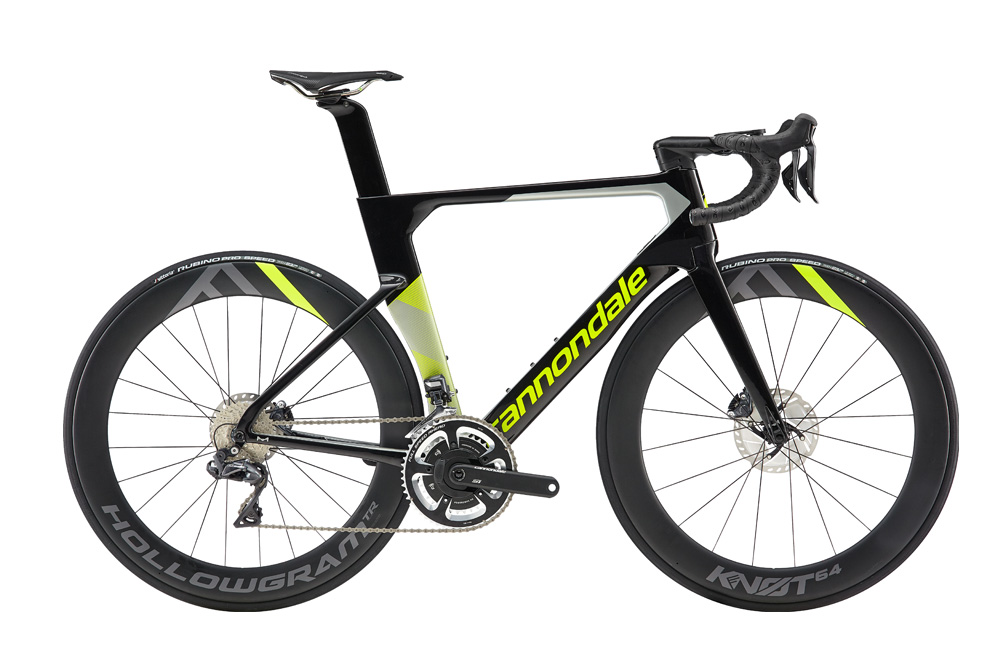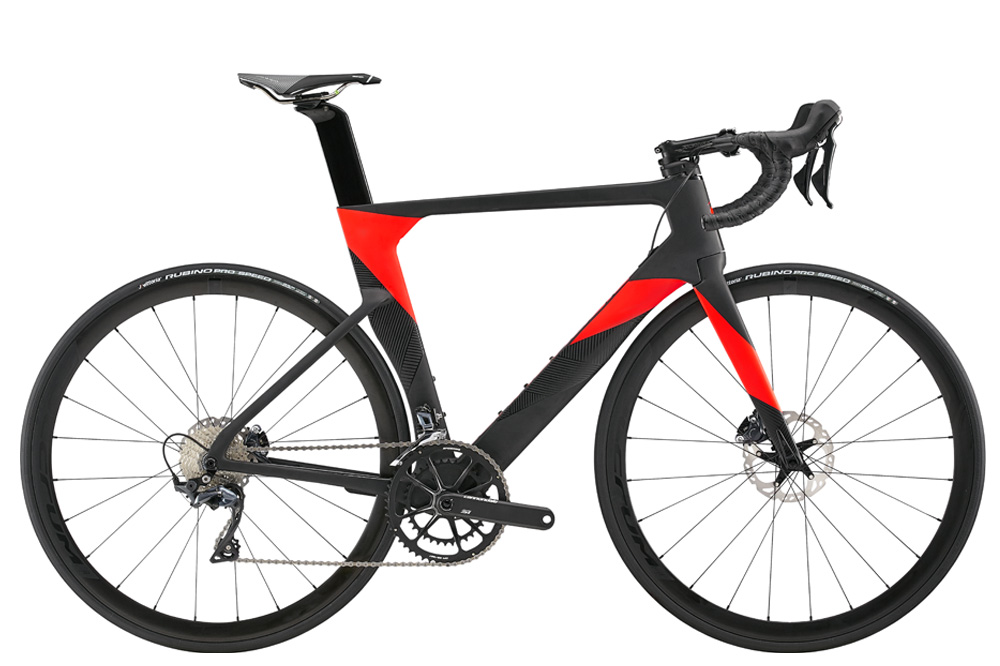Cannondale SystemSix: New aero bike comes complete with Power2Max power meter
The new Cannondale SystemSix fills the aero sized hole in Cannondale's lineup

Update 3/07/28 – Cannondale made clear to us that it made a mistake with the prices on the Hi-Mod Dura-Ace Di2 and the Hi-Mod women's bike. We previously listed the former as £7,999 but it has been corrected to £8,499.99 and the latter has been corrected to £6,499.99.
The little glimpses of the Cannondale SystemSix at the Dubai Tour were the first signs of the bike to fill the aero bike shaped hole in the Cannondale lineup.
That was a hole that left the brand's pro riders having to race the sprints on the SuperSix Evo, but now the new SystemSix feels like an attempt to break down potential aero elitism of bike riding in general, as well as the idea that aero bikes can't climb.

Cannondale SystemSix: How fast?
On the flat, the brand's research suggests drag becomes an enormous factor at any point above 15km/h, that's nine mph, meaning almost anyone can benefit.
The brand has done some fairly extensive research into the aerodynamics of climbing, and apparently, at any point up to a six per cent grade, the new bike and the Supersix Evo can climb at the same speed, with the lightweight bike only gaining the advantage when the slopes turn above that mark.
Obviously, what the pro riders wanted was a bike that can sprint, rather than having to race flat stages on the SuperSix Evo. By Cannondale's calculations, the SystemSix is approximately four bike lengths faster than the GC bike when riding at the same speed.

One potential aero advantage that is often overlooked in professional racing is descending, and Cannondale probably explained this in the best way I've heard – that a fast aero bike can be the difference between exerting substantial effort and snatching a bit of a rest on the descent.
The latest race content, interviews, features, reviews and expert buying guides, direct to your inbox!
To put that into context, on a five per cent gradient, descending on a SystemSix at 200 watts would equal 60kmh, whereas the SuperSix Evo would require 309 watts to match that.
Cannondale SystemSix: The bike
However, it's easy to get bogged down trying to crunch numbers, and it's far more rewarding to analyse the actual bike.
It's a complex concoction of aerodynamic shapes, and the frame sports truncated aero designs on the down tube, top tube and seat tube.
It also has a chine from the fork and across the head tube which is to re-attach the air to the frame once it has passed the head tube. The paint scheme on the women's Hi-Mod frame below makes this easy to understand as it is designed around the flow of air on the frame.

The frame is disc brake only, and there won't be a rim brake frameset. Not only were the brand able to optimise the bike around the more powerful brakes, but it means there's more room for wider tyres. Despite this, the SystemSix is optimised around narrow 23c rubber, although that blows up to 26mm on the new Knot 64 wheels.
Talking of which, these wheels are an exciting new addition to the Cannondale wheel line, which, As the name suggests are 64mm deep.
That's the same depth as the Roval CLX 64 wheels, their closest competitor and Cannondale says the wheelsets are of an equal speed. Having ridden both, the ride quality is also very similar. The Knot 64 wheels feel light, fast to accelerate and roll really well; they really help bring the bike to life.

However, that doesn't stop the tyre and rim combination looking a little strange, purely because the rim is so much wider than the Vittoria Rubino rubber that comes specced on the bikes. Initially, I was a touch puzzled by this because I'd heard that having tyres sitting flush against the rim was aerodynamically superior.
However, when I asked aerodynamacist Nathan Barry, he said that the smaller tyres on the wider rim helps re-attach the wind to the rim if it hits it at an angle.
Of course, the wheel can be ridden with large tyres, and the fame is capable of accommodating 25 and 28mm rubber; personally I would opt for the middle ground of 25.
The Knot moniker is also used on the bar stem combo; another neat piece of kit. The cabling runs underneath the stem, inside a plastic covering then down inside the head tube. However, the use of split spacers means you don't need to de-cable the bike to drop the stem height, instead you undo the plastic cap and then separate them around the steerer.
The bar and stem has the appearance of a one piece unit but is actually two separate parts. The bar sits in a cradle that offers eight added degrees of adjustability.
Cannondale SystemSix: Power meter

However, it's an unconventional partnership with Power2Max that steals the show. In particular, the two Hi-Mod bikes comes with a crank based power meter as standard – although it isn't activated. Once they've purchased the bike, consumers can then decide whether they want to activate the product for an additional £490.
The point of this being that the price of the power meter is kept separate to that of the bike. This differs from Specialized who incorporated its power cranks into the bikes retail price. As a result the Tarmac SL6 costs £9500, whereas the top level SystemSix costs £7999.
Once the power meter is activated, it's set for life but for this reason the bikes will only ship with Shimano drive chains, although they'll still use Cannondale cranks. The non hi-mod versions will also use Cannondale Spider chainrings.
Cannondale SystemSix: Other tech details
Speed Release is another very neat feature of the new SystemSix bike. Developed it conjunction with Mavic, the new thru-axle system only takes five turns to undo and the axle never leaves the hub. Apparently it's so that the axle doesn't get dropped or lost but it could potentially also make swapping disc brake wheels in the pro races a lot easier.
Cannondale SystemSix: First ride

Girona hosted the first rides of the Cannondale SystemSix, and although surrounded by mountains we managed to carve out a relatively flat loop; which is obviously this bikes advantage. The overbuilt tubing on the SystemSix does make the bike look heavy but there's undeniable stiffness in the frame that's partnered perfectly by the Knot 64 wheelset. A couple of pedal strokes is all it needed to get up to speed and hold it.
Of all the potential show stopping features on this on this bike, the Knot 64 wheels might the finest. They're deep but without any of the difficulties that can accompany that; such as slow acceleration or compromises on the handling.
There was one glaring omission in the launch though, and that was compliance. Maybe it's because this is the brand's first aero bike in years that it wanted to make clear just how fast it is, but there was no mention of just how comfortable it is; which is very.
Cannondale SystemSix: Models and prices

Cannondale SystemSix Hi-Mod Dura-Ace Di2 £8,499.99

Cannondale SystemSix Hi-Mod Dura-Ace Women's £6,499.99

Cannondale SystemSix Hi-Mod Ultegra Di2 £6,499

Cannondale SystemSix Carbon Dura-Ace (also in grey) £4,999

Cannondale SystemSix Carbon Ultegra (also in green) £3,499